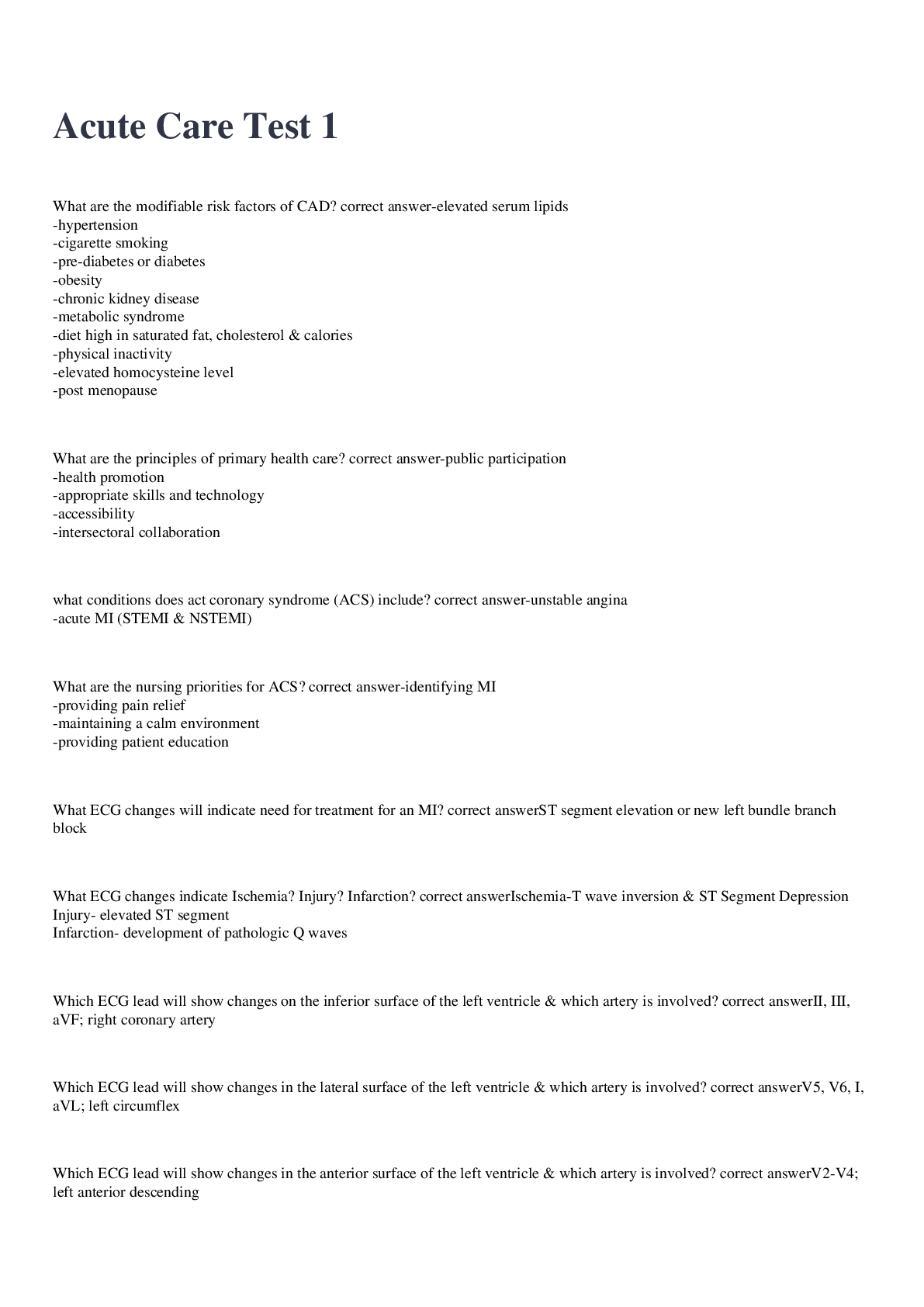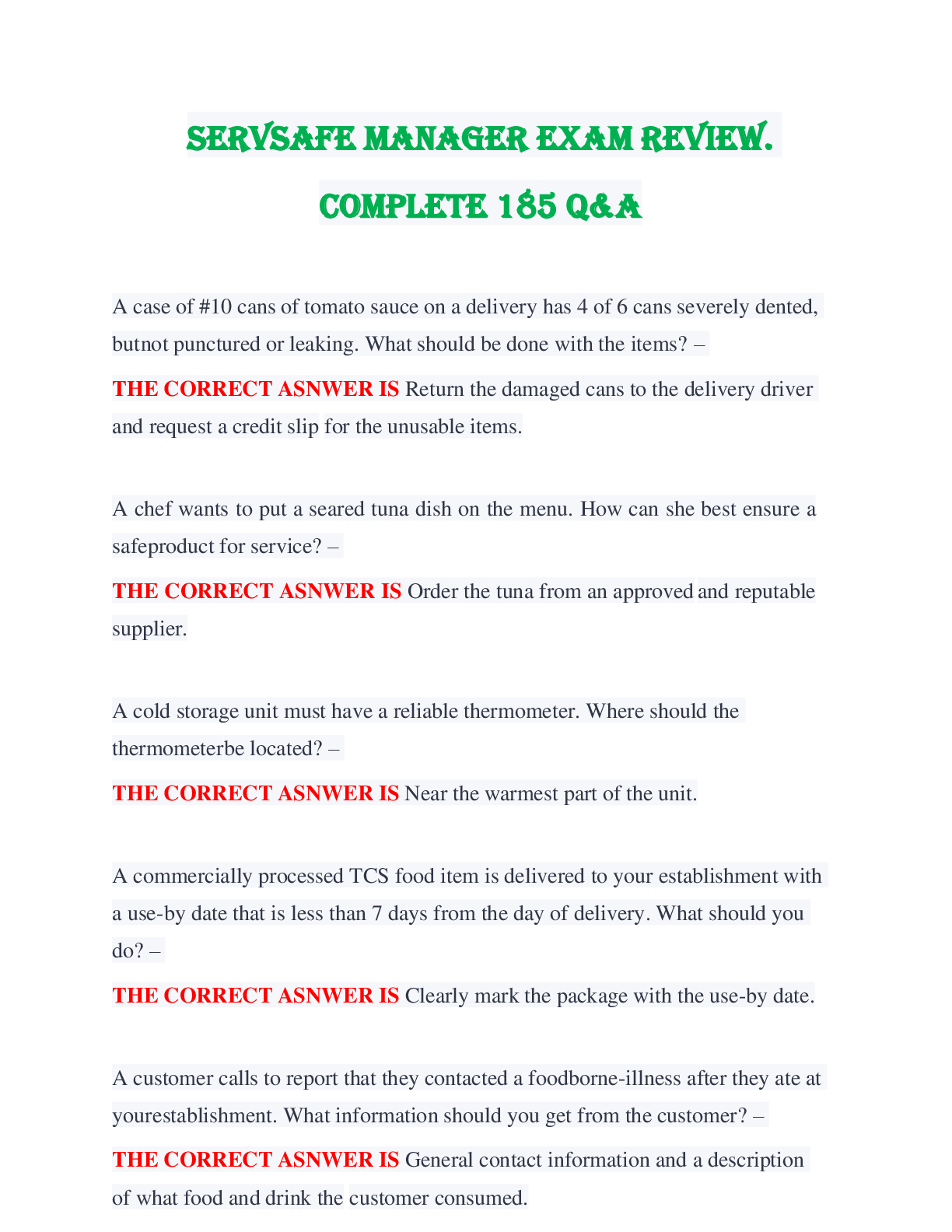Health Care > EXAM > Acute Care Test 1 exam 2022/2023 with 100% correct answers (All)
Acute Care Test 1 exam 2022/2023 with 100% correct answers
Document Content and Description Below
What are the modifiable risk factors of CAD? correct answer-elevated serum lipids -hypertension -cigarette smoking -pre-diabetes or diabetes -obesity -chronic kidney disease -metabolic syndrome ... -diet high in saturated fat, cholesterol & calories -physical inactivity -elevated homocysteine level -post menopause What are the principles of primary health care? correct answer-public participation -health promotion -appropriate skills and technology -accessibility -intersectoral collaboration what conditions does act coronary syndrome (ACS) include? correct answer-unstable angina -acute MI (STEMI & NSTEMI) What are the nursing priorities for ACS? correct answer-identifying MI -providing pain relief -maintaining a calm environment -providing patient education What ECG changes will indicate need for treatment for an MI? correct answerST segment elevation or new left bundle branch block What ECG changes indicate Ischemia? Injury? Infarction? correct answerIschemia-T wave inversion & ST Segment Depression Injury- elevated ST segment Infarction- development of pathologic Q waves Which ECG lead will show changes on the inferior surface of the left ventricle & which artery is involved? correct answerII, III, aVF; right coronary artery Which ECG lead will show changes in the lateral surface of the left ventricle & which artery is involved? correct answerV5, V6, I, aVL; left circumflex Which ECG lead will show changes in the anterior surface of the left ventricle & which artery is involved? correct answerV2-V4; left anterior descending Which ECG lead will show changes in the anterior lateral surface of the left ventricle & which artery is involved? correct answerV1-V6, I, aVL; left main coronary Which ECG lead will show changes in the septal surface of the left ventricle & which artery is involved? correct answerV1, V2; left anterior descending Which ECG lead will show changes in the posterior surface of the left ventricle & which artery is involved? correct answerV1, V2; left circumflex or right coronary artery What is an anterior & lateral wall MI associated with? correct answer-left ventricle pump failure -cardiogenic shock -death what are the symptoms of an anterior or lateral wall MI? correct answer-tachypnea -cyanosis -cough -bibasilar crackles -hypotension -tachycardia -S3 & S4 What is a inferior wall MI associated with? correct answer-heart block -conduction problems -right ventricular pump failure Symptoms of an inferior wall, posterior wall or right ventricular MI? correct answer-peripheral edema -JVD -increased CVP -brady dysrhthymias What is a right ventricular MI associated with? correct answer-heart block -conduction problems (inferior MI) -cardiogenic shock What are the medical priorities for an AMI? correct answer1. return blood flow to the myocardium (Fibrinolytics/ TNK or PCI) 2. Anticoagulation (Heparin or LMWH; Warfarin if A. Fib) 3. Dysrhythmia Prevention (Beta Blockers) 4. Prevention of Ventricular Remodelling (ACE-I or ARBs to prevent heart failure) Nursing Priorities of an AMI? correct answer1. Balance myocardial oxygen supply & demand 2. Prevent Complications (ie. hypotension & bleeding-from fibrinolytics, ASA, anticoagulants) 3. Assess for Depression 4. Provide Education How do you go about balancing myocardial oxygen supply & demand for an AMI? correct answer-increase coronary blood flow (IV nitro) -decrease activity (bed rest) -decrease cardiac workload (beta blockers) -increase cardiac contractility (inotropic drugs) Complications of MIs: correct answer1. Dysrhythmias (heart blocks, ventricular dysrhythmias) 2. Ventricular Aneurysm 3. Ventricular Septal Rupture (poor prognosis) 4. Papillary Muscle Rupture (sudden onset of a mitral valve murmur) 5. Cardiac Wall Rupture (poor prognosis) 6. Pericarditis (friction rub, ST elevation in all upright leads) 7. Heart Failure (may develop into chronic disease state) What is heart failure and what are the most frequent forms? correct answer-inability of the heart to pump blood at a volume require to meet the body's needs -impairs the ability of the ventricles to fill or eject blood *CAD and MI are most frequent; other causes include valvular dysfunction, infection, cardiomyopathy & HTN Systolic vs Diastolic Heart Failure? correct answerSystolic- decreased contractility of left ventricle Diastolic- decreased relaxation, stretching or filling of left ventricle during diastole Acute vs Chronic Heart Failure? [Show More]
Last updated: 2 years ago
Preview 1 out of 32 pages

Buy this document to get the full access instantly
Instant Download Access after purchase
Buy NowInstant download
We Accept:

Reviews( 0 )
$7.00
Can't find what you want? Try our AI powered Search
Document information
Connected school, study & course
About the document
Uploaded On
Dec 02, 2022
Number of pages
32
Written in
Additional information
This document has been written for:
Uploaded
Dec 02, 2022
Downloads
0
Views
63




















